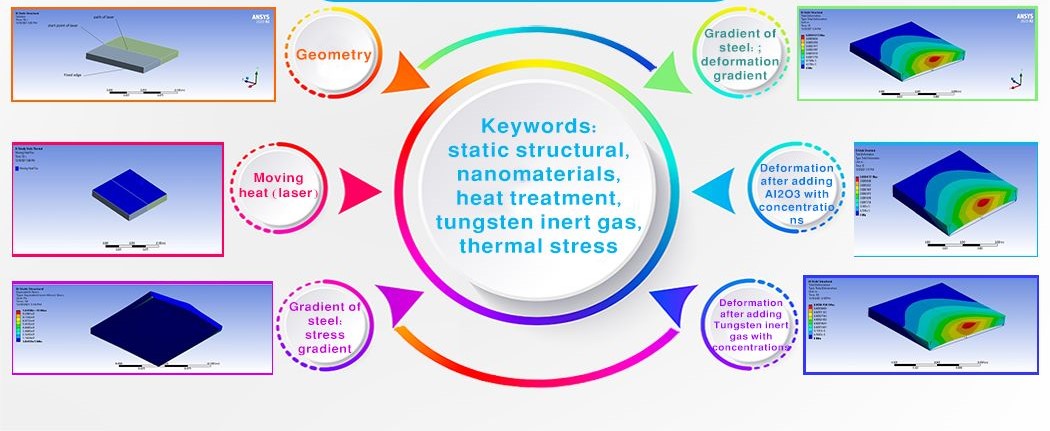Поліпшення механічних характеристик додаванням наночастинок і використанням лазерів при термічній обробці
DOI:
https://doi.org/10.15587/1729-4061.2022.269127Ключові слова:
статична конструкція, наноматеріали, термообробка, вольфрам, інертний газ, термічна напругаАнотація
З розвитком лазерної техніки в різних галузях машинобудування та виробництва з'явилася безліч застосувань у цих галузях та в галузі поліпшення механічних властивостей різних металів за їх здатністю протистояти різним термічним та механічним впливам та напругам. У цьому дослідженні додавання наноматеріалів та лазерного випромінювання тепла на них та знання їхньої здатності покращуватися. Процес проєктування простої моделі, що відповідає вимогам процесу моделювання, був виконаний у програмі Solid Works. Досліджувані розміри становили (100×100×10) мм3 заввишки та були розділені на частини. Сама перегородка – це шлях лазера. Необхідно перевірити надійність сітки, щоб сформувати відповідну сітку, яка може дати точні результати. Наночастинки, де Al2O3 та TIC використовувалися у різних пропорціях з основним матеріалом – це сталь, де ці співвідношення становили (0,3, 0,6, 1) мас. %. Результати показали, що процес додавання наноматеріалів позитивно впливає з точки зору стійкості матеріалів до тепла, механічних навантажень і навколишніх умов. Видно, що через результати зі збільшенням концентраційних значень додаванням наночастинок отримують суттєвий вплив на результати та значення термічних та механічних властивостей. Наноматеріал TIG (вольфрамовий інертний газ) призвів до підвищення температури у твердому тілі на 1 мас.% порівняно з іншими концентраціями та наноматеріалами. Додавання наноматеріалів при термообробці позитивно впливає величину деформації, оскільки найменше значення деформації було отримано в наноматеріалах при tic1 wt % проти інших концентрацій. Що стосується напруги, найбільша отримана напруга становить 10,502 ГПа.
Посилання
- D’Urso, L., Nicolosi, V., Compagnini, G., Puglisi, O. (2004). Size distribution of silver nanoclusters induced by ion, electron, laser beams and thermal treatments of an organometallic precursor. Applied Surface Science, 226 (1-3), 131–136. doi: https://doi.org/10.1016/j.apsusc.2003.11.012
- Badini, C., Pavese, M., Fino, P., Biamino, S. (2009). Laser beam welding of dissimilar aluminium alloys of 2000 and 7000 series: effect of post-welding thermal treatments on T joint strength. Science and Technology of Welding and Joining, 14 (6), 484–492. doi: https://doi.org/10.1179/136217108x372559
- Padovano, E., Badini, C., Pantarelli, A., Gili, F., D’Aiuto, F. (2020). A comparative study of the effects of thermal treatments on AlSi10Mg produced by laser powder bed fusion. Journal of Alloys and Compounds, 831, 154822. doi: https://doi.org/10.1016/j.jallcom.2020.154822
- Sanz, C., García Navas, V. (2013). Structural integrity of direct metal laser sintered parts subjected to thermal and finishing treatments. Journal of Materials Processing Technology, 213 (12), 2126–2136. doi: https://doi.org/10.1016/j.jmatprotec.2013.06.013
- Van den Eynde, M., Strobbe, D., Verkinderen, O., Verbelen, L., Goderis, B., Kruth, J.-P., Van Puyvelde, P. (2018). Effect of thermal treatments on the laser sinterability of cryogenically milled polybutene-1. Materials & Design, 153, 15–23. doi: https://doi.org/10.1016/j.matdes.2018.04.072
- Delgado, T., Nieto, D., Flores-Arias, M. T. (2015). Fabrication of microlens arrays on soda-lime glass using a laser direct-write technique and a thermal treatment assisted by a CO2 laser. Optics and Lasers in Engineering, 73, 1–6. doi: https://doi.org/10.1016/j.optlaseng.2015.03.026
- DiBernardo, B. E., Reyes, J., Chen, B. (2009). Evaluation of tissue thermal effects from 1064/1320-nm laser-assisted lipolysis and its clinical implications. Journal of Cosmetic and Laser Therapy, 11 (2), 62–69. doi: https://doi.org/10.1080/14764170902792181
- Haedersdal, M., Moreau, K. E. R., Beyer, D. M., Nymann, P., Alsbjørn, B. (2009). Fractional nonablative 1540 nm laser resurfacing for thermal burn scars: A randomized controlled trial. Lasers in Surgery and Medicine, 41 (3), 189–195. doi: https://doi.org/10.1002/lsm.20756
- Aboshi, A., Kurumoto, N., Yamada, T., Uchino, T. (2007). Influence of Thermal Treatments on the Photoluminescence Characteristics of Nanometer-Sized Amorphous Silica Particles. The Journal of Physical Chemistry C, 111 (24), 8483–8488. doi: https://doi.org/10.1021/jp0718505
- Mazzera, M., Zha, M., Calestani, D., Zappettini, A., Lazzarini, L., Salviati, G., Zanotti, L. (2007). Low-temperature In2O3nanowire luminescence properties as a function of oxidizing thermal treatments. Nanotechnology, 18 (35), 355707. doi: https://doi.org/10.1088/0957-4484/18/35/355707
- Stepanov, A. L., Hole, D. E., Townsend, P. D. (1999). Modification of size distribution of ion implanted silver nanoparticles in sodium silicate glass using laser and thermal annealing. Nuclear Instruments and Methods in Physics Research Section B: Beam Interactions with Materials and Atoms, 149 (1-2), 89–98. doi: https://doi.org/10.1016/s0168-583x(98)90733-9
- Ropyak, L., Schuliar, I., Bohachenko, O. (2016). Influence of technological parameters of centrifugal reinforcement upon quality indicators of parts. Eastern-European Journal of Enterprise Technologies, 1 (5 (79)), 53–62. doi: https://doi.org/10.15587/1729-4061.2016.59850
- Kasenov, S., Askerbekova, J., Tleulesova, A. (2022). Algorithm construction and numerical solution based on the gradient method of one inverse problem for the acoustics equation. Eastern-European Journal of Enterprise Technologies, 2 (5 (116)), 43–52. doi: https://doi.org/10.15587/1729-4061.2022.253568

##submission.downloads##
Опубліковано
Як цитувати
Номер
Розділ
Ліцензія
Авторське право (c) 2022 Lamyaa Mahdi Asaad, Iqbal Alshalal, Faten N. Al Zubaidi, Muna Khalil Asmail

Ця робота ліцензується відповідно до Creative Commons Attribution 4.0 International License.
Закріплення та умови передачі авторських прав (ідентифікація авторства) здійснюється у Ліцензійному договорі. Зокрема, автори залишають за собою право на авторство свого рукопису та передають журналу право першої публікації цієї роботи на умовах ліцензії Creative Commons CC BY. При цьому вони мають право укладати самостійно додаткові угоди, що стосуються неексклюзивного поширення роботи у тому вигляді, в якому вона була опублікована цим журналом, але за умови збереження посилання на першу публікацію статті в цьому журналі.
Ліцензійний договір – це документ, в якому автор гарантує, що володіє усіма авторськими правами на твір (рукопис, статтю, тощо).
Автори, підписуючи Ліцензійний договір з ПП «ТЕХНОЛОГІЧНИЙ ЦЕНТР», мають усі права на подальше використання свого твору за умови посилання на наше видання, в якому твір опублікований. Відповідно до умов Ліцензійного договору, Видавець ПП «ТЕХНОЛОГІЧНИЙ ЦЕНТР» не забирає ваші авторські права та отримує від авторів дозвіл на використання та розповсюдження публікації через світові наукові ресурси (власні електронні ресурси, наукометричні бази даних, репозитарії, бібліотеки тощо).
За відсутності підписаного Ліцензійного договору або за відсутністю вказаних в цьому договорі ідентифікаторів, що дають змогу ідентифікувати особу автора, редакція не має права працювати з рукописом.
Важливо пам’ятати, що існує і інший тип угоди між авторами та видавцями – коли авторські права передаються від авторів до видавця. В такому разі автори втрачають права власності на свій твір та не можуть його використовувати в будь-який спосіб.










